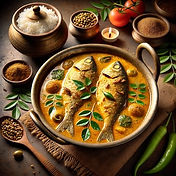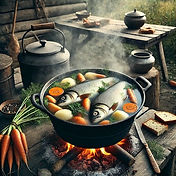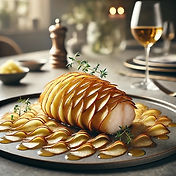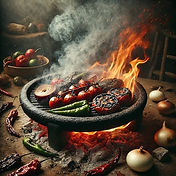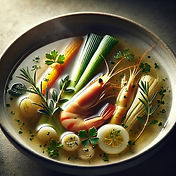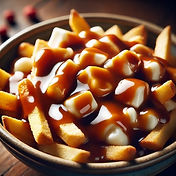Top Chef ™: Wisconsin
Season:
Week:
Duality

The chefs traveled to Madison and toured buildings designed by architect Frank Lloyd Wright.
Working in pairs, the contestants had to take inspiration from Wright's architectural style and create dishes featuring the theme of duality. The dishes were served at Wright's estate, Taliesin, in Spring Green. The winning pair received US$10,000, though only one person received immunity for the next Elimination Challenge. Both members of the losing team were eliminated. The guest judges were chef Dominique Crenn and Top Chef ™ winner Buddha Lo.

Get recipes ...
Subscribe to our weekly recipes and culinary tips from streamed cooking shows.
Dishes prepared in
Top Chef ™: Wisconsin
Chef Charly: "What we have is a play on the chicken and the egg. What I've done is a black mushroom haitian rice called Djondjon. It's a whipped eggs mousse. Shards of chicken skin, pickled mushrooms, and peas."
Chef Amanda: "My dish is about wealth, so I am using more luxurious ingredients. I have scallop, caviar, and some roe and angel hair pasta."
Chef Dan: "Amanda and I were a team and took a lot of our inspiration for our duality with the Burnham blocks. Frank Lloyd Wright designed buildings that were meant for low income housing. There are three ingredients for this whole dish - potatoes, leeks, and kombu. We have a leek cannoli with a potato mousse, brown butter and potato foam, potato tuile, and then a potato and pickle kombu salad." My plate is about scarcity.
Chef Manny: "Our duality is light and dark. Mine was light. So we have chicken and mushroom fiori and bubbles of sauce poulet au Vin Jaune. I'm practicing my French!"
Chef Kevin: "My dish, it's a warm, praline chocolate mousse. I really want to work, like, the shape of the triangle, because it means the strength, and I feel like in the world today, we really need to be better and stronger together. Love each other."
Chef Michelle: "Today I did the chicken portion of our chicken and the egg. This is a play on a childhood dish that I grew up eating. I did a mushroom biscuit with chicken liver mousse in the center, sous vide chicken breast, topped it with stewed apples, and then chicken fried chicken skins."
Chef Savannah: "We really wanted to lean into compression and release. The compression is an emotional feeling of being a little bit uncomfortable before you get the release of walking into a much wider space. You have dry aged ribeye with tempura maitake and a beet daikon roshi. And the sauce is a traditional tempura sauce that is thickened with wild pistachio, which is a spice that is not super common."
Chef Laura: "And then you get the opposite dish. It's actually a sweet dish. The connection between the two dishes is actually the pistachios. So you get the filo pistachios from Turkey and pistachio foam and a sauce of raspberries. It's something that's lighter and makes you feel like you are in relief."
Chef Kaleena (during prep): "I have my cheesecake out of the freezer. The crust came out way too hard, and the cheesecake basically didn't quite set to the point that it should have."
Chef Alisha (in response): "We don't have precise cuts on our dishes, and the whole point of our dish is precision. I feel like we're just two separate chefs, like plating and doing our own food plan."
During presentation to the judges:
Chef Kaleena: "With the dessert, I have a mushroom and goat cheesecake. There is a sesame and nori tuile on top, some candied mushrooms, and a little bit of spruce syrup."
Buddha Lo: "And what was on the base of the cheesecake?"
Chef Kaleena: "Cornmeal crust. And then the cheesecake is set on top of it."
Chef Alisha: "For me, I made an aguachile. I poached the shrimp very lightly, so the cucumber, I actually took oysters, and I made, like, a brine out of it."
Chef Danny made a spinach scallop mousse with a zucchini purée and some pickled and compressed zucchini batons.
Chef Rasika: "I'm basically making a daal that is going to be shaped into a quenelle, with a carrot puree and a consommé called rasam and beetroot that has been poached and pickled. I just want everything to be aromatic and not overly spicy."
Culinary Challenges inspired by
Top Chef ™: Wisconsin
Meen Moilee is a celebrated Kerala fish curry that exemplifies South Indian coastal cuisine. This luxurious dish features firm white fish gently poached in a velvety coconut milk sauce infused with aromatic spices. The preparation begins by sautéing curry leaves, green chilies, ginger, and onions until fragrant, then adding turmeric, ground spices, and coconut milk to create a golden, creamy base. The fish is carefully added last, allowing it to cook just until tender. The hallmark of Meen Moilee is its balanced flavor profile - mild heat complemented by tanginess from tomatoes or sometimes vinegar, sweetness from coconut milk, and brightness from fresh lime juice. Served with rice, this curry represents the perfect harmony of Kerala's abundant seafood and tropical ingredients.
Ukha is a traditional Russian clear fish broth that dates back centuries, revered for its clean, delicate flavors. This aromatic soup begins by gently simmering whole fish—typically freshwater varieties like pike, perch, or sturgeon—with minimal vegetables and aromatics, allowing the pure essence of the fish to shine through.
The preparation is deliberately simple: fish, onions, carrots, bay leaves, black peppercorns, and occasionally potatoes or leeks. What distinguishes ukha is its clarity—the broth should remain transparent, never cloudy. Often finished with fresh herbs like dill or parsley and a splash of vodka, authentic ukha embodies Russian cuisine's philosophy of highlighting natural flavors rather than masking them with excessive seasonings.
Pommes de terre en écailles, meaning "scaly potatoes" in French, is an elegant potato preparation technique that transforms the humble tuber into a sophisticated side dish. Thin-sliced rounds of peeled potatoes are meticulously arranged in overlapping patterns resembling fish scales or roof tiles in a buttered dish. Each layer is brushed with melted butter and seasoned with salt and pepper before the next is added. The assembled potatoes are then baked until the edges turn wonderfully crisp while the centers remain tender.
The result is a visually striking dish with beautiful textural contrast—crispy, golden exterior scales protecting creamy interiors—that elevates any meal with its refined presentation and rich buttery flavor.
Dawadawa is a traditional West African fermented seasoning made primarily from locust beans (Parkia biglobosa), though occasionally from soybeans or other legumes. The preparation begins by boiling the beans until soft, then pounding them to remove the seed coats. The cleaned seeds are boiled again, spread out, and covered with leaves to ferment naturally for 2-3 days. This fermentation process develops a pungent aroma and complex, umami-rich flavor profile. The resulting black paste is typically shaped into balls or patties for storage. Used as a flavor foundation in soups, stews, and sauces across Ghana, Nigeria, and other West African countries, dawadawa adds remarkable depth and nutritional value to countless dishes.
You can buy dawadawa spice here.
Pipian is a rich, traditional Mexican sauce that exemplifies the complexity of pre-Hispanic cuisine. Made from ground pumpkin or squash seeds (pepitas), this velvety sauce incorporates various chiles, spices, and sometimes nuts or seeds like sesame or peanuts. The ingredients are toasted, ground into a paste, and simmered with broth until thickened to a smooth consistency. Pipian can range from vibrant green (pipian verde) to deep red (pipian rojo), depending on the chiles used. Commonly served over poultry or pork, this sauce offers a nutty, earthy flavor profile with subtle heat that showcases Mexico's remarkable ability to balance complex flavors into harmonious dishes.
Tatemado is a traditional Mexican cooking technique most commonly associated with Jalisco cuisine. This slow-cooking method involves placing ingredients—typically meat such as pork, goat, or beef—into clay pots that are partially buried in hot coals or placed in an underground pit oven. The pots are sealed with masa (corn dough) to trap moisture and smoke, allowing the meat to cook gently for several hours until incredibly tender. This process imparts a distinctive earthy flavor while preserving the meat's natural juices.
Tatemado dishes are often seasoned with regional spices, chiles, and herbs, creating complex flavor profiles that showcase Mexico's rich culinary heritage. The result is meltingly tender meat with unparalleled depth of flavor.
Nage, pronounced "nahj," is a fragrant, aromatic broth used in French cuisine primarily for poaching seafood and vegetables. This delicate liquid is typically created by simmering wine, water, or fish stock with aromatic vegetables (onions, celery, fennel) and herbs. After cooking, the ingredients may be strained out, and the remaining liquid can be reduced and enriched with butter to create a "beurre monté" sauce.
The term 'nage' is also used to describe dishes cooked in this liquid—referred to as "à la nage"—resulting in light, flavorful preparations that highlight the natural taste of the main ingredient while infusing it with subtle complexity.
Poutine: Quebec's Beloved Comfort Food
Poutine is a Canadian culinary treasure originating from Quebec in the late 1950s. This hearty dish consists of three essential components: crispy french fries, cheese curds, and rich brown gravy poured generously over the top, creating a delicious mess of contrasting textures and flavors.
The magic of poutine lies in its seemingly simple yet perfectly balanced combination. When done right, the fries remain crisp on the outside while soaking up savory gravy. The cheese curds, which must be fresh to achieve their signature 'squeak' between your teeth, soften slightly from the heat without fully melting. The gravy ties everything together with its savory depth. It is basically a roux, traditionally thickened with chicken or beef stock but a vegetarian option is just as good, with flavor from umami-rich mushrooms or earthy beets.
To create authentic poutine at home, begin with freshly cut potatoes, twice-fried for optimal crispness - first at a lower temperature to cook through, then at a higher temperature for that golden exterior. The cheese curds should be room temperature and as fresh as possible. Their slightly tangy flavor and distinctive texture cannot be substituted with shredded cheese. For the gravy, create a flavorful stock reduction, thickened to a consistency that coats the back of a spoon without being gloopy.
Assembly requires careful timing. The fries must be piping hot from the fryer, immediately topped with curds and quickly covered with steaming gravy that's hot enough to warm the curds but not so hot it melts them completely.
While traditional poutine remains a beloved classic, modern variations might include toppings like pulled pork, smoked meat, or even lobster. Whether enjoyed from a roadside stand in rural Quebec or prepared in your kitchen, poutine represents comfort food at its finest. it is unpretentious, indulgent, and deeply satisfying.
Soba Cha (also known as Soba-Cha and Sobacha) is Japanese buckwheat tea. It is drunk hot or cold, and is gluten-free and caffeine-free and apparently tastes nutty and slightly sweet.
It appeared three times in Top Chef: Wisconsin ™. The first showing was in Restaurant Wars when Danny's team, under his leadership, served up cold Soba Cha as a welcome drink. It wasn't well received.
In reparation, Danny re-introduced it in week 12 when he infused mushrooms into Soba Cha for his fish dish. This time, the judges regretted that he had buried the flavor of the buckwheat tea in very powerful mushroom flavors and would have preferred the essence of the tea to shine through.
Danny didn't try again, but Dan used Soba Cha in his Smoked Dashi and this time it went down a storm.
Hummingbird cake is a Jamaican banana and pineapple spiced cake which has been eaten in the southern United States since the 1970s. It is a leavened cake with a salty cake and often contains pecans.
Mofongo is a Caribbean dish originating in Puerto Rico and the Dominican Republic. Made by mashing ripe plantains with fat, garlic, spices, and (optionally) pork crackling, it is then shaped into a ball. The dish is famous for its complex and contrasting textures, with fried plantains that are crispy on the outside and soft on the inside. It is often found topped with melted cheese and served with a clear garlic broth.
Danny, in the 'spoiler' for the Top Chef Wisconsin Finale, was heard to say that he wanted to get fresh scallops for his first course and treat them in the style of "Leche de Tigre".
Leche de tigre, (translates to tiger's milk), is the Peruvian term for a citrus marinade that cures fish or seafood. Also known as leche de pantera, this marinade usually contains lime juice, onion, chile, and fish sauce.













